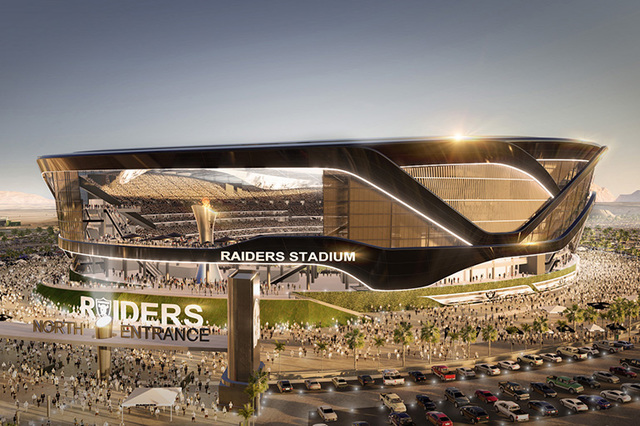Report recommends speeding up $899M in freeway projects to support proposed Raiders stadium
The Nevada Department of Transportation would need to accelerate at least $899 million in Las Vegas freeway improvements if a new stadium opens by 2019 at either of the two sites under consideration by the dome’s developers, according to a report released Thursday by Gov. Brian Sandoval’s office.
The report shows the bulk of the costs would be dedicated to projects that add high-occupancy vehicle lanes, also known as carpool lanes, which can be used only by vehicles with at least two occupants during peak travel periods.
State lawmakers are meeting in special session this week to decide whether to approve public financing for the stadium’s construction.
In a document filed Monday with the Legislature, NDOT reported the stadium would have no fiscal impact on the agency.
“Since the development of the transportation projects in this area of Las Vegas was already planned, there is no fiscal impact above and beyond what NDOT assumed it would deliver in southern Nevada,” the document said.
“The prioritization of projects in southern Nevada is subject to revision, but that is consistent with the current process in which the Transportation Board of Directors adopts amendments and modifications on a quarterly basis.
“NDOT is not seeking additional funding for projects in southern Nevada which may coincidentally support traffic generated from special events held at a future stadium.”
Sandoval requested the study last month, saying he wanted to determine traffic impacts and the cost of road upgrades needed to support a $1.9 billion stadium. A 62-acre area northwest of Russell Road and Interstate 15 and the 140-acre Bali Hai Golf Club, between Interstate 15 and Las Vegas Boulevard, just south of Russell, are the two leading locations for the stadium.
CH2M was paid $150,000 to examine the traffic impacts that a 65,000-seat stadium — the proposed home of the NFL’s Oakland Raiders and the UNLV football team — would bring to the two resort corridor sites, according to NDOT.
The company recommended:
■ Adding one lane of traffic in each direction of Interstate 15 and adding carpool lanes between Tropicana Avenue and Blue Diamond Road for $274 million.
■ Building five direct-access ramps from the carpool lane to five exits along I-15, including Harmon and Hacienda avenues, for $400 million.
■ Rebuilding the Tropicana Avenue interchange at I-15 for $150 million.
■ Building carpool-lane ramps directly connecting I-15 and the 215 Beltway for $75 million.
The improvements are already planned for construction between 2020 and 2035, but they remain essentially unfunded.
To get the projects fast-tracked, NDOT will need to delay other improvements planned for the local highway system, Director Rudy Malfabon said.
“We won’t do all $800 million-plus in the next few years because we don’t have that much right now,” Malfabon said.
NDOT would have to rely on federal and state resources, with the 10-year extension of a fuel indexing tax that Clark County voters will consider on the Nov. 8 ballot under Question 5.
“The stadium will be paying for its proportionate share of the infrastructure costs,” said Mari St. Martin, a spokeswoman for Sandoval.
“The director has advised that the road projects are scheduled and will be built regardless of whether or not the stadium is built,” St. Martin said. “The fiscal note provided by the department to the Legislature on the stadium project indicated there would not be a financial impact to NDOT’s existing planning.”
The stadium developers have set aside $375 million to buy the land, pay for on-site infrastructure improvements such as utility lines and roads surrounding the stadium.
Additional transportation improvements that would not be funded by NDOT include an extension of the Las Vegas Monorail from the MGM Grand to Mandalay Bay, which was estimated last year at $100 million to cover the cost of tracks, a new station and two new trains.
The stadium’s developers would be responsible for building a proposed pedestrian bridge that would go over Interstate 15, linking the Mandalay Bay monorail station to the stadium. The cost of the bridge is unknown.
The Regional Transportation Commission of Southern Nevada would need to develop additional bus routes to help alleviate traffic around the stadium, according to the report.
The family of Las Vegas Sands Corp. Chairman and CEO Sheldon Adelson has pledged $650 million to the proposed stadium project, while the Raiders have committed $500 million.
The report noted that the Russell Road site was the preferred site by developers. Vehicle access could be limited at the Bali Hai site, which is surrounded by McCarran International Airport to the east, Interstate 15 to the west and the Union Pacific railroad line to the south.
“This may result in higher levels of congestion at spot locations near the site, as opposed to the Russell Road location, which may experience a greater dispersion of traffic particularly to the west,” the report said.
Southwest Airlines, the busiest commercial carrier at McCarran, also raised concerns that airport operations could be restricted if the stadium was built at the Bali Hai site.
The report projected 15,613 vehicles would travel to games and major events held at the Russell Road site, with 60 percent arriving by car, 24 percent by shuttle or public transportation, 8 percent walking or bicycling and 6 percent taking a limousine, taxi or ride-sharing service.
The Review-Journal is owned by the family of Sheldon Adelson, chairman and CEO of Las Vegas Sands Corp.
Contact Art Marroquin at amarroquin@reviewjournal.com or 702-383-0336. Follow @AMarroquin_LV on Twitter. 
NDOT Las Vegas Stadium Traffic Assessment by Las Vegas Review-Journal on Scribd
RELATED
Lawmakers may kick final decision on Raiders stadium to Clark County Commission
Rural, Northern Nevadans see pros, cons of Raiders Stadium in Las Vegas
Approval of Las Vegas stadium plan might face bumpy ride in Nevada Assembly
Gov. Brian Sandoval must feel confident that Raiders stadium deal will pass
Raiders stadium project for Las Vegas clears Nevada Senate in 16-5 vote

















